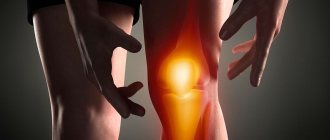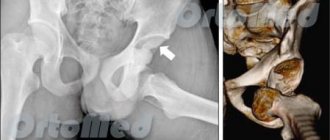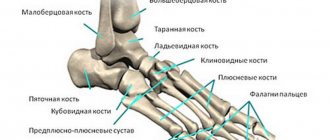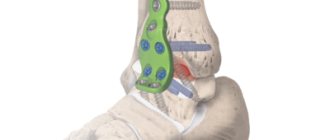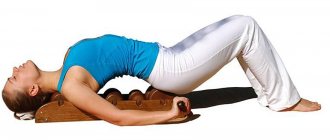Causes of frequent fractures in the “60+” category
As we age, metabolic processes slow down, the body loses its ability to regenerate, and osteoporosis progresses. In older people, bone density often decreases - height decreases, stooping and pathological curvature of the spine appear under its own weight. These processes are accompanied by invisible microtraumas that occur during any sudden movements.
With arthrosis, cartilage tissue wears out - individual areas of the bones rub, causing pain. It is not surprising that they gradually deform, lose strength, and microtraumas and cracks appear on them.
In addition, in old age, due to problems with the cardiovascular system, many people complain of weakness and dizziness. This increases the risk of slipping and falling - both on a slippery road and in everyday life, when performing usual actions.
According to statistics, about 10% of Russian residents suffer from osteoporosis - brittle bones
Classes of drugs prescribed for fractures
Nonsteroidal anti-inflammatory drugs inhibit the synthesis of prostaglandins, thereby reducing the development of swelling, redness, and pain. Such drugs include diclofenac sodium, meloxicam, nimesulide, ketoprofen, ibuprofen, which have been recognized by many years of practice as the standard for the treatment of inflammation and pain of connective tissue.
Painkillers for fractures can be taken on average from 10 days to three months. The longest period of use is allowed for the coxibs group due to their high safety.
Among the traumatologist's prescriptions you can often find calcium-containing drugs, chondroitin sulfate, glycosaminoglycans, which should be regarded as medicines for fractures for rapid healing of bones. They significantly accelerate the process of restoration of bone, periosteum and, above all, cartilage tissue, regeneration of nerve endings and blood vessels.
These drugs do not change pain sensations, but are an important element of the treatment regimen. Their use will significantly improve the healing process by increasing the number of actively dividing bone cell complexes.
Such tablets after a fracture are recommended mostly for the elderly, patients with deforming osteoarthritis, and other concomitant diseases. They are well tolerated and have virtually no contraindications. The minimum duration of treatment is three months.
What are the dangers of fractures in old age?
Despite innovative technologies in the field of bone healing and an extensive arsenal of painkillers, fractures are still very dangerous for older people. Among such patients, each illness is severe, and even a seemingly mild injury can lead to death.
- Bones take much longer to heal than in young people due to slow metabolism and insufficient blood supply to skeletal tissue.
- Temporary immobilization and mandatory bed rest weaken the body and negatively affect the emotional state.
- The risk of thromboembolism increases - the formation of blood clots in the lower extremities and, as a result, blockage of the pulmonary artery.
Elderly people who have suffered fractures often lose faith in recovery
Foods that slow down bone healing
Along with healthy foods needed to speed up bone healing after a fracture, there are also those that slow down recovery.
Alcohol comes first on the list of harmful substances. It disrupts the process of callus formation and promotes the destruction of nerve connections. In addition, while intoxicated, it is easy to fall and get a new injury.
List of products to exclude:
- alcohol;
- semi-finished products;
- smoked, spicy, salty foods;
- strong coffee and tea;
- fatty food;
- sweet carbonated drinks.
Features of treatment and rehabilitation
At this age, bones are often unable to heal on their own, so they resort to osteosynthesis - a surgical operation to connect the fragments with a metal plate. Sometimes total joint replacement is indicated - replacing a bone joint with an implant, especially if the clinical picture is accompanied by arthrosis. Operations are extremely dangerous at this age, so their feasibility is determined by the doctor in each case individually.
The main problem of the recovery period at this age is difficulties with the patient’s movement. After prolonged immobilization, patients lose muscle mass, and also, what is much more serious, interest in life. Many quickly get used to a wheelchair and are skeptical about the prospect of rehabilitation. The result is obvious.
According to statistics, one in three people aged 65 and older suffers a fall once a year. Every tenth leads to serious consequences, such as a hip fracture. Here are some effective balance exercises to help prevent falls:
A set of exercises to develop muscles after a leg fracture
You should regularly perform exercises that will help your muscles quickly gain tone and restore normal balance when walking. It is recommended that you first seek the help of a doctor or exercise therapy instructor, who will monitor the correct execution and explain in detail how to develop an ankle after a fracture.
With a ball
The patient presses a special ball, a physioball, against the wall with his lower back. The feet and torso are pushed forward. You should squat smoothly so that the ball does not fall. The knees should bend until a right angle is formed (90°).
On the platform
Standing on an unstable surface, the healthy leg should be slightly bent at the knee. First you just need to learn how to balance and keep your balance. After mastering it, you can take the ball and, without losing a stable position, throw it at the wall and catch it. Exercise activates stabilizer muscles and restores balance.
Jumping
You need to jump on each leg alternately along the line marked on the floor. With each jump you need to land on different sides. The hip muscles are strengthened, balance and coordination of movements are trained. By how easily this can be done, one can assess the degree of development of the joint after an ankle fracture.
On a roller
Alternately stand with your foot on the bolster, and with the other foot you need to perform moderate swings back and to the side. For stability, the leg standing on the roller must be slightly bent, while keeping it straight. You can use a loop of elastic tape attached to the bottom of the wall. It is put on the leg that swings.
You can simply stand on your leg while maintaining your balance using the elastic loop on your other leg. Legs must be alternated.
If you follow the doctor’s advice and your own desire and perseverance, joint mobility is completely restored in a fairly short time.
Features of fractures of different bones
- Fractures of the radius.
When falling onto an arm outstretched in front of them, older people often injure the distal radius. If the fracture is simple, it is enough to apply a plaster splint or a polymer bandage. When the doctor suspects difficult fusion of fragments or diagnoses their displacement, knitting needles are applied.
After treatment, a special rehabilitation set of exercises is prescribed for approximately 6 weeks to restore muscle strength in the limb. In the presence of arthrosis of the wrist joint, rehabilitation is more difficult, since movements are limited and often cause additional pain.
- Fracture of the neck of the humerus.
This injury is also common among the elderly and occurs as a result of a fall from a height of one’s own height onto the elbow or a sharp tug on the arm. If the fracture is not accompanied by displacement, the arm is simply fixed using a special bandage. If the fragments have separated, they are combined under local anesthesia or a skeletal traction procedure is performed. In severe cases, plates are applied. The immobilization period is at least 6 weeks.
- Supracondylar fractures.
They happen when you fall on your arm - they are less common than others, but they also cause great discomfort to a person, especially if he has already progressed osteoarthritis of the elbow joint. A plaster cast is applied to the limb, the arm is fixed with a bandage, and in severe cases, skeletal traction of the arm or surgery is performed.
- Femoral neck fracture.
This area is very poorly supplied with blood, which explains the long fusion of bones. In old age, such a fracture rarely occurs without surgery - most often osteosynthesis is practiced using a knitting needle, plate or pin. The rehabilitation period consists of long months of exercise therapy, physiotherapy and other measures to restore mobility.
90% of patients who fractured a femur are over 65 years of age
- Trochanteric fractures of the femur.
They are also a consequence of osteoporosis - brittle bones. The femur heals very slowly, so treatment is rarely possible without surgery. The recovery period takes at least six months. These patients require assistance with daily routines. Housing needs to be adapted to their needs, taking into account their low mobility.
- Fractures of the tibial condyles.
Such knee injuries do not occur as often in old age as the consequences of osteoarthritis of the knee joint. The fracture is accompanied by hemorrhage into the knee cavity. The patient is given a plaster cast or an Ilizarov apparatus is placed. Sometimes it is necessary to install plates or screws. During a long recovery period of at least 6 months, physiotherapy, massages and other activities are carried out.
- Ankle fractures.
Occurs as a result of a person falling on a twisted leg or due to inaccurate tucking of the legs. Treatment tactics are the application of a plaster splint with a metal “stirrup” so that the patient can rest on the injured leg without a crutch. If the case is simple, the healing period does not exceed two months.
Fractures of the femur in old age are the most dangerous
What to do if a fracture occurs? Timely treatment
The main symptom is pain, joint
it bends unnaturally. You can get injured anywhere. This will be a workplace, for example, at a construction site, where you fell unsuccessfully and stumbled upon bricks, or on vacation, when, while riding a bicycle, you crashed into a tree. Knowing that a fracture can be life-threatening, a person immediately consults a doctor. It’s better to hear that you just have a bruise than to get bone suppuration and amputation of a limb.
What is the danger of fractures?
Let us highlight a number of consequences when the integrity of the bone is violated:
- The movement of the injured limb is impaired, which will have consequences without treatment.
- Damage to blood vessels, which leads to blood loss and hematoma formation.
- If several fractures are sustained at once, traumatic shock is possible, often leading to death.
- The broken bone digs into the fat deposit, which leads to an embolism, which ends with the person becoming, at best, disabled, and at worst, dying.
- If the fracture is not treated, it will lead to suppuration of the bone, which will cause the development of sepsis, and subsequently gangrene, leading, at best, to amputation, at worst, to death.
The body is designed in such a way that it is usually difficult to make a mistake when there is a fracture. The injury is associated with severe pain, as the broken bone continues to move, tearing blood vessels and muscle tissue with its sharp end. Only pain is not always a 100% sign of a fracture. Perhaps it’s just a bruise, but with a low pain threshold, it seems that the bone has shattered. Also, damage to soft tissue can cause more pain than a fracture.
How do you know if you have a fracture?
Two types of signs can be distinguished:
- Relative, since symptoms do not always indicate possible bone damage;
- Absolute – indicating a violation of the integrity of bone tissue.
Let's pay attention to the second type of symptoms in order to accurately diagnose ourselves:
- The limb is unnaturally twisted. Even without an x-ray, anyone can determine that there is bone damage. Although a simple dislocation is possible. But still, you will have to urgently go to the doctor.
- The bend of the limb is unnatural, for example, in the other direction.
- Bones crunch – we are talking about crepitus. You should not deliberately twist the injured limb, as this is very painful. But if a person, sitting on a gurney, hears a crunch, then this is definitely a broken leg. Crepitation is felt.
- With an open fracture, bone fragments are clearly visible. In addition, the skin is damaged, and severe bleeding is possible if an artery is damaged.
Now let's talk about the relativity of symptoms:
- The bruised area hurts, especially severely if you try to move the limb.
- The appearance of edema - at the site of the fracture, the arm or leg becomes especially swollen.
- When a blood vessel ruptures with a broken bone, a hematoma forms.
- Mobility is severely impaired. It’s difficult to stand on your leg, or you can’t hold anything in your hand.
Absolute symptoms are observed only when the injury is severe. Usually people are faced with relative signs, when it is difficult to diagnose themselves. Therefore, after a fall and if you experience pain, you should go to the emergency room, where there is an x-ray.
Type of fractures
The classification is broad. It has to do with how the bone damage occurred. First you need to understand how this damage was caused:
- As a result of injury, that is, it is influenced by external factors.
- Due to pathology, when the bone is affected inside the body. It could be tuberculosis of the bone, cancer, or something else that destroys bone tissue, making it less strong.
Integrity violations are also classified according to severity:
- With or without displacement, the bone breaks completely;
- Just a crack or break - the bone does not break into pieces.
By the way the skin behaves, integrity violations can be classified. Depending on whether you have a closed or open injury, you will need to proceed differently. But in any case, you should consult a doctor.
In the first case, the skin is not damaged, there are no wounds at the site of the injury. In the second, the bone protrudes outward from the wound, a lot of blood flows, and you can get an infection.
Fractures are also classified according to the degree of complexity. Some are simple and some have complications. In the latter case, destroyed bone tissue leads to heavy bleeding, infection through an open wound, which causes sepsis and fat embolism. Internal organs can also be damaged if there is a fracture, for example, of the ribs.
How to behave if you have a fracture
It is necessary to follow several simple rules to avoid further destruction of bone tissue, as well as painful shock, which often leads to death:
- If injured, do not put any weight on the injured limb.
- In case of an open fracture, bandage the wounded area using a sterile bandage.
- If an arm or leg moves unnaturally, you need to apply a splint. A stick, board, ski, plastic panel, in general, long, flat objects that are at hand are suitable for this. The main thing is that the limb does not move, thereby destroying blood vessels and muscle tissue, which can lead to shock and then even death.
- You should visit the hospital immediately after a fall. Even if the reasons for the fracture are not obvious. The sooner a specialist helps you, the easier and better it will be for your limb.
- It happens that the doctor diagnoses it as a bruise. But if you have severe pain for three days, when no ointment or lotions help, you should visit a specialist again. Perhaps the picture was taken poorly and the fracture went unnoticed.
If, nevertheless, your bone integrity is compromised, you will be given a plaster cast.
After recovery, you will need to undergo rehabilitation. Author: K.M.N., Academician of the Russian Academy of Medical Sciences M.A. Bobyr
Prevention of fractures in old age
Orthopedists recommend thinking about this problem without waiting for old age. At any age, it is advisable to lead an active lifestyle, choose feasible sports, and eat right. In order to prevent osteoporosis and fractures, you can stick to a diet that resembles diet therapy for arthrosis. It is necessary to add sea fish, dairy products, butter, cottage cheese, cheese, yogurt, all types of cabbage, nuts and spinach to the menu.
A special vitamin and mineral complex for bones will also not be amiss. If you are already worried about joint pain, get diagnosed to know the enemy by sight. Degenerative-dystrophic changes in cartilage tissue contribute to bone fractures, so coxarthrosis or gonarthrosis should not be ignored. Timely courses of intra-articular injections of liquid endoprosthesis will help avoid complications.
Is it possible not to use medications?
The need for the use of medications depends on the severity of the manifestation of the pain syndrome, aggravated trauma history and the duration of convalescence.
Which medications to take for fractures, and which ones can be neglected, is the subject of medical analysis: the doctor proceeds from each specific situation, including taking into account conditions that prohibit the use of certain groups of pharmaceutical substances for the patient.
An obvious example: people with hyperacid gastritis and stomach ulcers should avoid anti-inflammatory tablets, since these drugs significantly stimulate the release of hydrochloric acid by parietal cells.
Steroid drugs can be dangerous after bone fractures: they relieve pain, but have many contraindications.
In the first stages, you should always give preference to the oral method of administration. Only if there is no effect during the day, you can resort to parenteral administration of the substance, but not exceeding the daily and single dose.
Only a doctor is able to determine the correct tactics for drug treatment in a particular case, and treatment of fractures with drugs is no exception.
